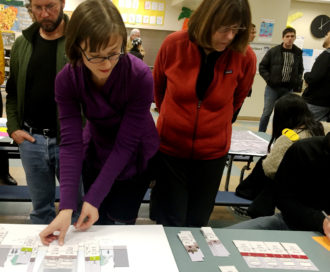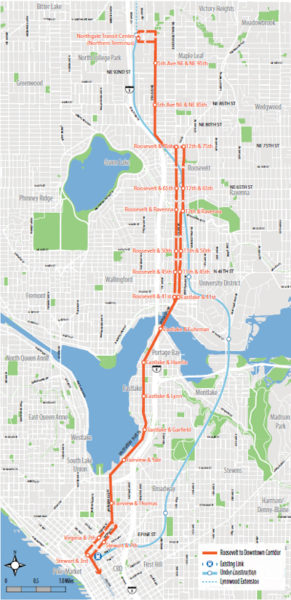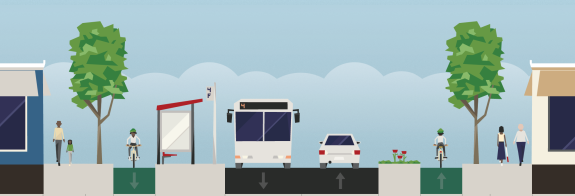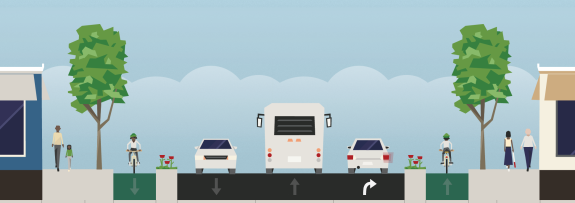
Seattle has the chance to finally build a safe and comfortable bike route from the University Bridge to downtown. But more than that, the city also has the chance to create a safer and more inviting main street for the Eastlake neighborhood and improve local transit service.
But this won’t happen without your strong support. SDOT is hosting a new set of open houses Wednesday and Thursday to discuss their latest updates on the Roosevelt-to-Downtown High Capacity Transit Project (meeting content will be the same at each open house):
- Wednesday, 6 – 8 p.m. at TOPS School, Cafeteria
- Thursday, 6 – 8 p.m. UW Tower, Cafeteria North
You can also comment online.
Community support for protected bike lanes on Eastlake Ave is very broad. The Eastlake Community Council endorsed including protected bike lanes in a series of letters to SDOT this winter (here and here), noting that alternative route options would likely not be used as well as Eastlake Ave itself. They also suggest that the city include more and better bike parking in business districts so that the new people biking on the road can more easily stop and patronize businesses there (great idea!).
 But wait, isn’t this a transit project? What about bus lanes?
But wait, isn’t this a transit project? What about bus lanes?
Good question! I’m eager to see how the city’s studied options have evolved and how transit times compare between them. Because as we explored in a previous post, exclusive bus lanes can fit on Eastlake Ave, but only at the expense of quality bike lanes and/or sidewalk space, neither of which are exciting trade-offs. If planners can figure out how to fit bus-only lanes and create a safe street with good bike lanes, I’m eager to see it.
On the other hand, traffic volumes are not so high on Eastlake (between 14,000 and 15,000 vehicles per day, including bikes). Improvements like in-lane bus stops can help prevent delays because buses wouldn’t need to wait for passing traffic before merging back into the travel lanes (the law says people need to yield to merging buses, but few actually do this). Strategic and smart placement of turn lanes would also help keep the travel lanes flowing, helping bus travel times. Smart traffic signals and bus “queue jump” signals can also help get buses around traffic backups.
Beyond all this, I wonder if efforts to get people driving through the area to use I-5 instead of Eastlake would also help keep traffic levels lower.

 With in-lane bus stops, there is space for turn lanes where needed to keep traffic and buses flowing. This truly complete streets design would be a boon for Eastlake businesses, would speed up buses and would finally create a safe and direct bike route on the east side of Lake Union.
With in-lane bus stops, there is space for turn lanes where needed to keep traffic and buses flowing. This truly complete streets design would be a boon for Eastlake businesses, would speed up buses and would finally create a safe and direct bike route on the east side of Lake Union.
Beyond Eastlake
Our coverage of this project has been very focused on Eastlake because it is such a huge bike route missing link and also the most difficult stretch to design. But there are also opportunities to improve the Roosevelt/11th/12th corridor and to connect through South Lake Union to downtown.
At this point, our comments are pretty much the same as in our previous post: Let’s do it! Specifically,
- Building protected bike lanes on 11th/12th Ave NE like the lane under construction on Roosevelt makes obvious sense.
- Building protected bike lanes on Fairview Ave N (connecting South Lake Union to Eastlake) is also a no-brainer.
- Bike lanes on Fairview Ave N between Stewart and Valley are also a great idea, but let’s make sure they are protected.
- Stewart needs protected bike lanes for its entire length, so building them in this project is a good start.








Comments
22 responses to “Support safe Eastlake bike lanes this week”
“I wonder if efforts to get people driving through the area to use I-5 instead of Eastlake would also help keep traffic levels lower.” — You don’t drive on I-5 very much, do you?
This is Called ”The Seattle Bike Blog”
Don’t be so facetious. If we slow down cars on Eastlake enough, they will eventually be pushed onto I-5, so Tom has a valid point
I think the point is that drivers who are going cross-town and who should be taking I-5 in the first place, are diverting to eastlake because of its parallel nature. This clogs up eastlake ave and makes it a less friendly environment for everyone else. Keeping those cars on I-5 is a great idea.
I blame part of the problem on gps navigation software, which aggressively directs drivers onto quieter streets whenever the main road is congested enough that the route planning algorithm believes it will save a few seconds.
If we could somehow get Google, et. al., to add a slight bias to their navigation software, in favor of staying on the highways and main roads (without telling anyone of course), that would go a long way.
Yay…
Thanks for sharing the link. I submitted the follow requests:
– Remove 100% of parking along Eastlake from University Bridge to SLU
– Prioritize bus travel as #1, Cycling #2 & turn lanes if they can fit!
– NO cycletracks or “protected” bike lanes please. Normal Bike lanes with a little hashed buffer would be perfect and much easier to keep clean.
– Please mirror the wonderful Dexter Bike lanes as much as possible.
“Normal Bike lanes with a little hashed buffer would be perfect and much easier to keep clean” and a lot easier for cars and trucks to access every time they want to use the bike lane as convenient short term parking or loading zone! No thanks.
William, please also make that comment to the official record in the link. Protected bike lanes are key to increasing the number of people comfortable biking beyond the few brave ones now. Sure my children, timid co-worker and elderly aunt can’t pedal as fast as Mr. Squirrel, but they still want to go places by bike!
Cool thing about protected bike lanes is that they are a great place to park a pedestrian butt too. What poses more of a danger, a parked truck or parked human? I took this on my commute this morning, the men standing up were completely oblivious and turned into me as I passed https://imgur.com/a/RcT1D
I personally would much rather slow down for an oblivious pedestrian or even collide with them if they jump in my path than be forced out into traffic where I might be hit by a car.
Once we have more bike lanes that are more a part of the sidewalk than the road, pedestrians are likely to become more aware but the bottom line is that many protected bike lanes require bikes to slow down when pedestrians are around. If you want to go 20+ miles and hour, you probably have to brave the traffic.
@Molly, Did as you suggested.
Somewhat surprisingly, I’ve found the safest time to ride a bike along Eastlake to be during the morning and evening commute hours. The reason is because at time, there actually a critical mass of bikes on the road to allow the right-hand car lane to effectively function as a bike+right turn lane only. It’s still not perfect, as buses still have to constantly weave in and out of the bike lane to service the bus stops, but it’s still pretty good – at least for a couple hours each weekday morning and evening.
It would be really nice if we could get the protected bike infrastructure to make Eastlake a decent bike route at all times, not just during rush hour. Getting rid of the parking would be a huge political battle, but one definitely worth fighting.
Lastly, of course, we need bike facilities for the final approach into downtown along Stewart St. Currently, there’s nothing, and Olive Way is especially bad, going the other direction when you have to move all the way to the left lane on a bike in order to take the fork to Howell, and on to Eastlake.
During rush hour there are parking restrictions on Eastlake, which opens up a lot more space for bicycles. It doesn’t help much for those of us who leave work after 6. There are often one or two cars ignoring the restriction that will force you back into the lane.
I personally find that painted lanes usually end up with a delivery truck or shuttle bus parked in them, or a right turning car or several. I’ve never encountered either of those even during dark rainy winter storms on say the paint-and-plastic section of 7th. I ride to and in downtown now in winter because the protected lanes that exist make it is far safer than Eastlake. Driver behavior overall does change significantly where protected lanes are in effect. I’ve also watched my ride videos and noticed I rarely have to look over my shoulder in a paint-and-plastic lane. That’s not true of paint-only routes.
As for car traffic, it is reasonable that Eastlake should not be a cut-through neighborhood. There are obviously drivers trying to find the quickest way through it from somewhere else. I’ve done it myself. What’s worse is there is significant traffic volume even on side streets next to Eastlake Avenue proper, turning the school area into an on-ramp. Those frazzled individuals aren’t people stopping to run an errand and enjoy an evening. Mad Max cycling through doesn’t necessarily encourage exploring the food and shopping options either, nor does playing human Frogger to cross the street. My personal bike/bus shopping has largely taken place in Downtown, Northgate and Lake City over the last year even though Eastlake’s the direct route. If I’m riding 7 miles through an urban gauntlet, I’m staying focused on getting home alive and just having stuff shipped in via Amazon.
Rapid Ride transit and safe bike infrastructure will make this a far more inviting neighborhood to walk through and linger in without contributing to the traffic jam. It will have plenty of remaining capacity for driving to businesses. The North side of Lake Union has only boomed in the face of similar changes. Check out the Fremont Brewing parking lot here, and compare that to Mammoth’s parking lot in Eastlake http://jenandtraciego.com/2015/06/offbeat-seattle-walking-tour-with-immersus-tours/
@asdf2: Yep, totally true that Eastlake is much better to ride during rush hour. It seems to basically function as one lane for car traffic in each direction at any given time. During rush hour, the bikes claim the outer lanes. During non-rush hour, the parked cars claim the outer lanes. From the standpoint of traffic flow, it seems that putting in bike lanes wouldn’t impede car traffic much. But of course parking would be reduced, and I know that business would be unhappy about that.
Hurrah for Eastlake, but will Rainier Valley ever get any infrastructure? Eastlake is just the latest project to cut ahead of Rainier. Sigh.
Rainier absolutely needs improvements. But by what definition is Eastlake “cutting”? This project has been planned for years!
N Seattle will soon have 4 first-class routes to center city – Interbay, Dexter, Westlake and Eastlake. Rainier Valley has no safe way downtown and no routes between the Urban Villages of RV.
So yeah, Al, you skipped ahead of us again. Congratulations.
Within the past few weeks, SDOT has installed this interesting little bike/ped cut through in Ballard. I’m standing at 46th St on the small through connection on the west side of 15th Ave. The cut through is nice for me to get to Shilshole and east to the BGT, instead of going down 46th toward 11th. The redone ramp on the north side is a head scratcher though:
http://imgur.com/i2RNEL1
http://imgur.com/M9l39oR
I think I’ll be able to make it tonight. I hope that we can achieve a first class set of bike lanes along with real bus lanes. It will be tricky (even if you take out the parking, you only have so much space). If push comes to shove, I will prioritize BRT, just because of the enormous potential there — http://seattletransitblog.com/2016/01/09/support-full-brt-with-roosevelt-hct/.
This might mean that bike lanes get moved to the side streets, which is less than ideal. Unlike the Madison BRT project, everyone wants to use the same street, which is a shame. At least that is the case much of the way. For the bridge and north of there, both should fit (just make one of the general purpose lanes a bus lane and add or keep the bike lanes). Towards the south end (South Lake Union) there should be options that allow for bike lanes on parallel streets (as was the case with Madison BRT). It is that section on Eastlake that is challenging.
My understanding was that center-running dedicated transit-only lanes cost something like 3x the budget of the “targeted investment” option, so that’s what was doing the shoving rather than a bike vs. transit space trade-off. It sounds like the most likely option through Eastlake is BAT lanes, which should leave room for protected bike lanes (or empty car storage). If the city can find a way to do a full dedicated lane bus rapid transit through Eastlake, I’d be the first to start looking for safe bike routes on parallel streets. That said the Eastlake section is short enough that BAT lanes, queue jumps, off-board payment, wider stop spacing, signal priority, level boarding and such should still make for a short rush-hour travel time. SLU car dependence should also be dropping a lot in the near future. The increased number of #70 buses, Link expansion and the RapidRide C to SLU have already made a noticeable difference.
I went to the meeting tonight and it was interesting. To a certain extent, you are right. If they spent the money, then they could have both center running and bike lanes on Eastlake. But that would be (as you say) extremely expensive, because you would have to start cutting into the sidewalk and moving utilities. They looked at running the bike lanes on side streets, and it turns out it was much *worse* than they thought (and they thought it was bad to begin with). So that would have been expensive as well (lots of new pavement, etc.). So they will go with what you suggest (lots of small improvements).
I’m OK with that. My main concern is downtown (where there is no bike/bus) conflict. It seems to me like they don’t go far enough, but they are the ones doing the study. I just worry that what they consider good enough isn’t as good as it could be. Primarily though, the big conflict is not bus versus parking (as people often assume it is) but bus versus money or bus versus general traffic. SDOT is willing to take parking lanes (you can always park somewhere else) but they aren’t willing to let general purpose traffic go to hell. This makes a lot of sense, even though it is a bit frustrating. If you screw up traffic too bad, you end up with buses (most of which don’t run in dedicated bus lanes) screwed up as well (along with freight and ordinary drivers who we shouldn’t ask to suffer too much).